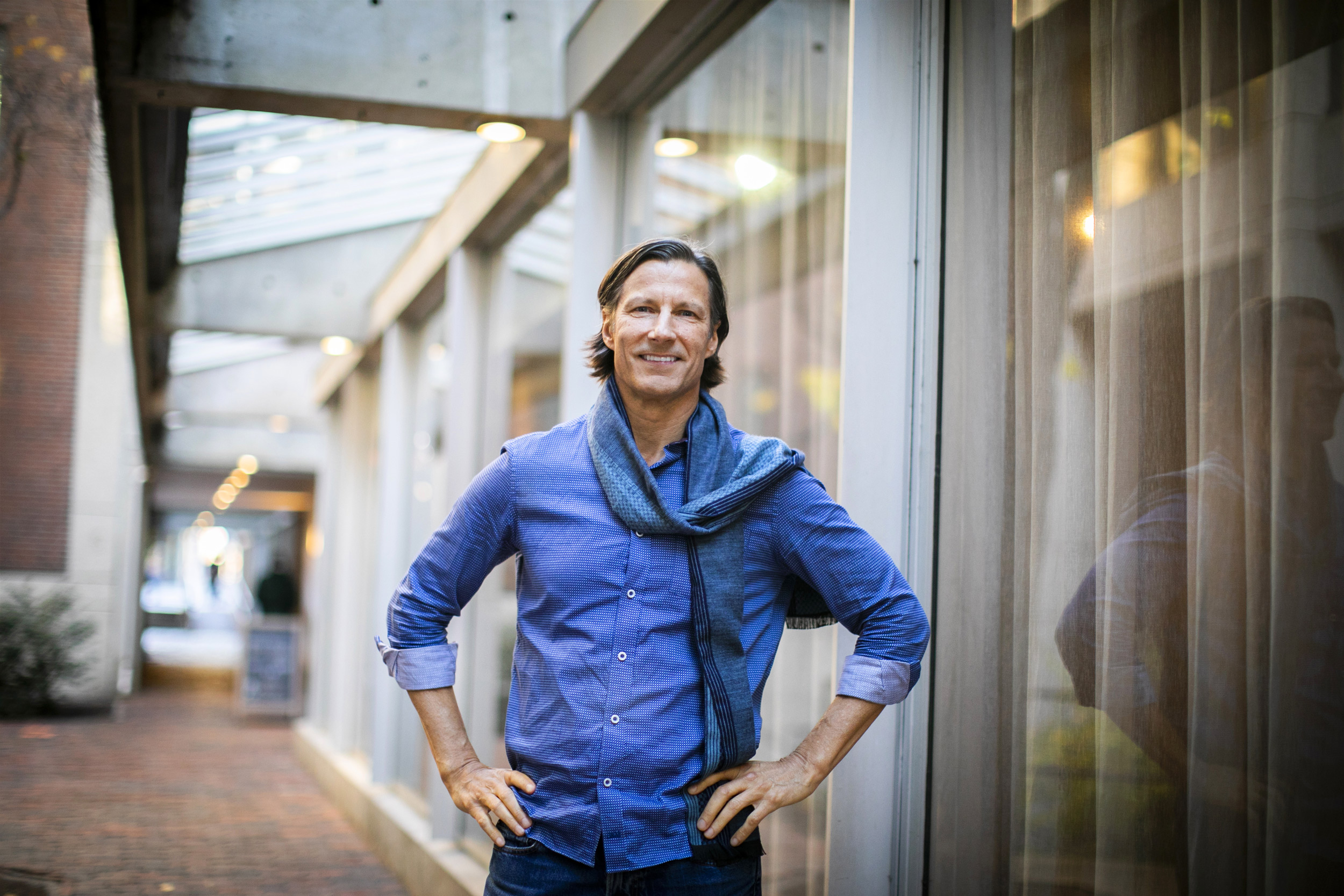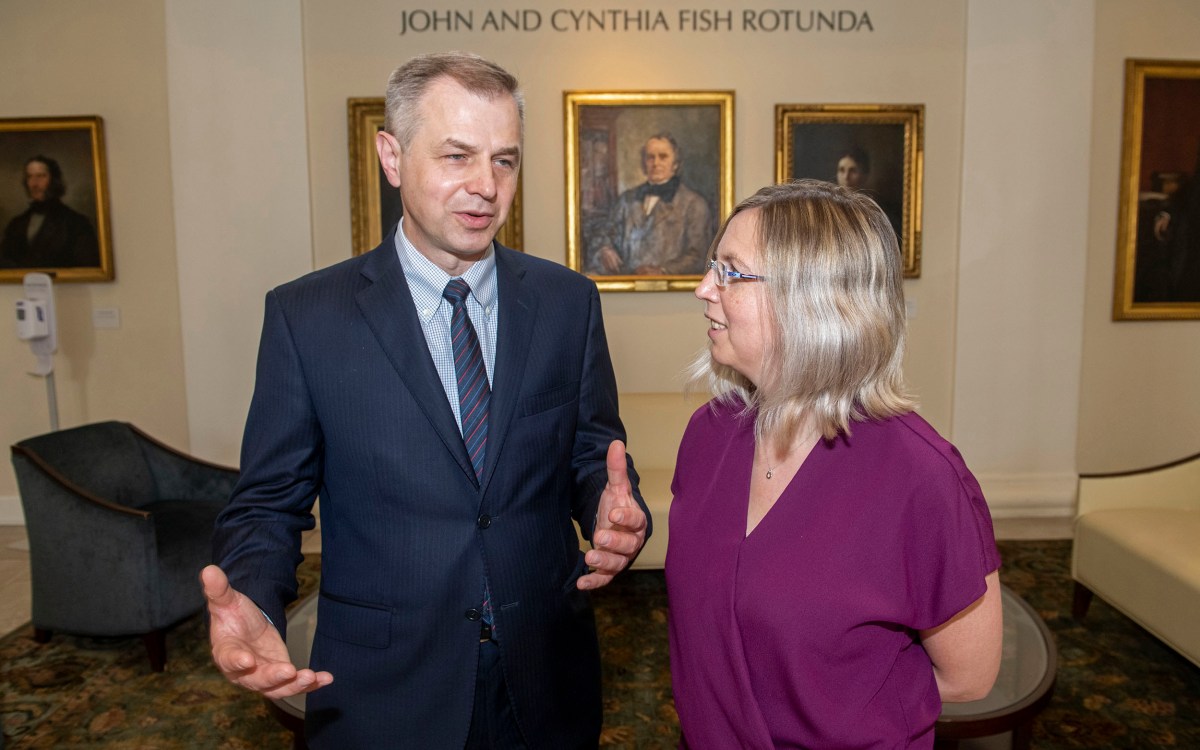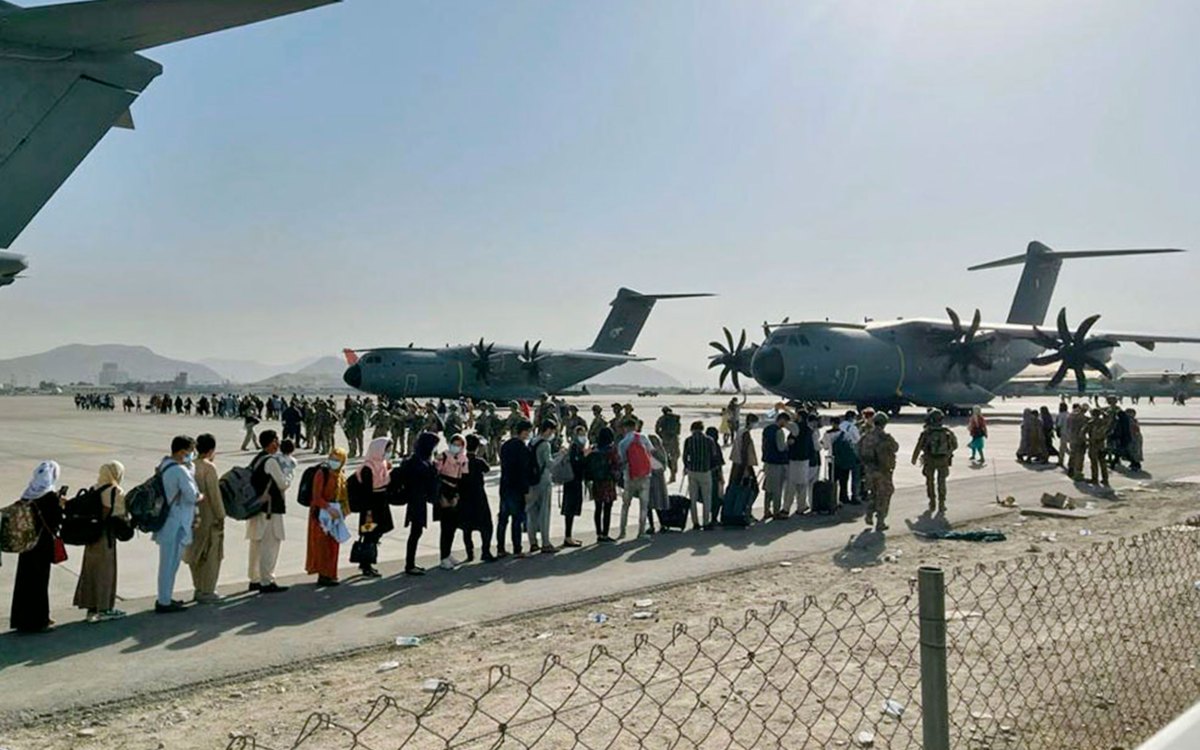
“I suggest thinking of principles in giving, rather than focusing on specific organizations,” says Michael VanRooyen, who encourages financial donations with a focus on local needs.
Stephanie Mitchell/Harvard Staff Photographer
Send cash, not goods, and other suggestions for giving
Michael VanRooyen, director of the Harvard Humanitarian Initiative, on navigating a world of conflict and need
Around the world, the holidays don’t always mean home, hearth, and happiness. For tens of millions of people, including those caught up in the 15 international emergencies listed by the United Nations High Commissioner for Refugees, the season offers no break from hunger, danger, and uncertainty.
For those looking to help, opportunities abound—but where and how can be confusing. The Gazette spoke to Michael VanRooyen, a specialist in emergency medicine and director of the Harvard Humanitarian Initiative, about targeting donations to meet global need. The interview has been edited for clarity and length.
Q&A
Michael VanRooyen
GAZETTE: With war such a dominant factor in humanitarian crises, I was thinking about the “Christmas Truce” of World War I, when troops laid down their arms for a day. Can a holiday interrupt combat or make displaced people forget their situation, if only for a few hours?
VanROOYEN: For holidays that are observed by both sides — during Ramadan or Eid, for example — there can sometimes be a brief pause, but most conflicts do not respect holidays. How refugees or people who are displaced — we have a huge number of displaced populations around the world — celebrate holidays is mostly with loss, because what it throws in sharp relief is the incredible loss of their lives and their families, disruption of their traditions and ability to gather as a community.
GAZETTE: Is Ukraine the worst humanitarian crisis right now?
VanROOYEN: Actually, no. Ukraine has become, obviously, very important and a spotlight event. To institutional donors like the U.S. government, it’s become a conflict that has drawn a lot of attention, a lot of media, and a lot of resources. But we have crises around the world that have far more need than Ukraine. So, while there are people who suffer from displacement and attack in Ukraine — 14 million are refugees or displaced inside Ukraine — the number of people under threat of dying and requiring urgent food aid in the Sahel famine, for example, is orders of magnitude larger. The conflict in Yemen and the drought and famine in Somalia are truly desperate situations. But these areas get far less attention because they’re protracted crises, and there’s donor fatigue when it comes to funding them. But they are by far the biggest humanitarian emergencies.
“The conflict in Yemen and the drought and famine in Somalia are truly desperate situations. But these areas get far less attention because they’re protracted crises, and there’s donor fatigue when it comes to funding them.”
GAZETTE: Where is HHI focusing its efforts?
VanROOYEN: Mainly in areas affected by conflict, including Ukraine. We also have programs in Somalia, Sudan, and, when we can work through international aid organizations, in places like Yemen and Afghanistan. HHI supports the work of aid agencies in most conflict areas. Most of our programs are not direct service delivery, but they typically are educational programs, training programs, data gathering, and support of other organizations that are working in the field.
GAZETTE: Is it important for your programs to go to places where the problems are severe?
VanROOYEN: Working in war and disaster is our mission. The work that we do is very much linked to the field, and as much as possible, we work with organizations directly on the ground. The problem is that there are so many restrictions on access to humanitarian aid corridors and on the ability to provide aid to those in need that even the experienced organizations can’t get to where they need to go. In many cases, it’s difficult to send teams from Harvard to conflict areas. So we work remotely in many places or by supporting local or international organizations that work in the field.
GAZETTE: Is there anything special HHI does for people out in the field over the holidays?
VanROOYEN: The first thing for us is always assuring that people are safe and in close contact. When we deploy people to the field, they’re always experienced professionals and are there because they are both committed and capable of working in a complex environment. Over the holidays, we make sure that they have as much contact with home base as they can, which, in a virtual era, is a little easier than it used to be.
“While there are major causes to get behind internationally, I am inclined to focus on some of the many domestic problems facing our communities, like homelessness and poverty.”
GAZETTE: Do you have suggestions for people in the U.S. who want to help others through donations? Are there emergencies that you would put at the top of your list?
VanROOYEN: I suggest thinking of principles in giving, rather than focusing on specific organizations. The first principle, I would say, is to give cash, not goods. When you’re donating, whether locally or nationally or globally, cash or direct finance is best. That’s because organizations who are working directly with people in the field know how to best spend resources effectively, and people who are displaced by war or disaster know how best to spend their money to support their families. Second, I would try to give as locally as you can, to groups operating in or near affected regions. If there are organizations that are working locally, or have access to local populations, I’d give to them directly. In an era of electronic money, it’s easier to do than ever. But giving locally is not always easy, and that requires homework.
GAZETTE: How do you vet local organizations?
VanROOYEN: There’s a misconception that giving to local organizations is risky, because there is less monitoring and accountability. I don’t think that’s necessarily true, and reputable local organizations can spend money much more efficiently and with less overhead costs. One of the ways to find these organizations is through websites. There’s Charity Navigator, which ranks charities by their ability to provide efficient and cost-effective services. Another is Give Well, which can help you look for high-impact philanthropic investments. Say, for example, you want to get the best bang for the buck caring for people affected by the famine in the Sahel, you can find organizations that do that well and you can also determine what kind of interventions are most needed. Finally, don’t be afraid to give to organizations unconditionally. For any organization that uses donated funds, as HHI does, the most valuable funds are the ones not designated for a specific cause, so that money can be spent on what the organization believes to be most impactful. Unrestricted funds donated to a reputable organization that works in a local capacity are some of the best investments you can make.
GAZETTE: What about people who want to volunteer, donate time, and physically go and help? Does it depend on your skills?
VanROOYEN: At an international level, it’s almost never useful to have volunteers. There are of course exceptions for highly technical fields, but in general there are very few circumstances where a volunteer can really add value to an organization. Usually, international volunteers are more expensive, ill prepared, and not a good cultural fit for the team in the field. I would not encourage international volunteers in complex settings.
Even though I work in a global setting, when I think of donating, I think locally. While there are major causes to get behind internationally, I am inclined to focus on some of the many domestic problems facing our communities, like homelessness and poverty. I am more inclined to support some truly innovative local organizations that can translate modest investments into real action.







